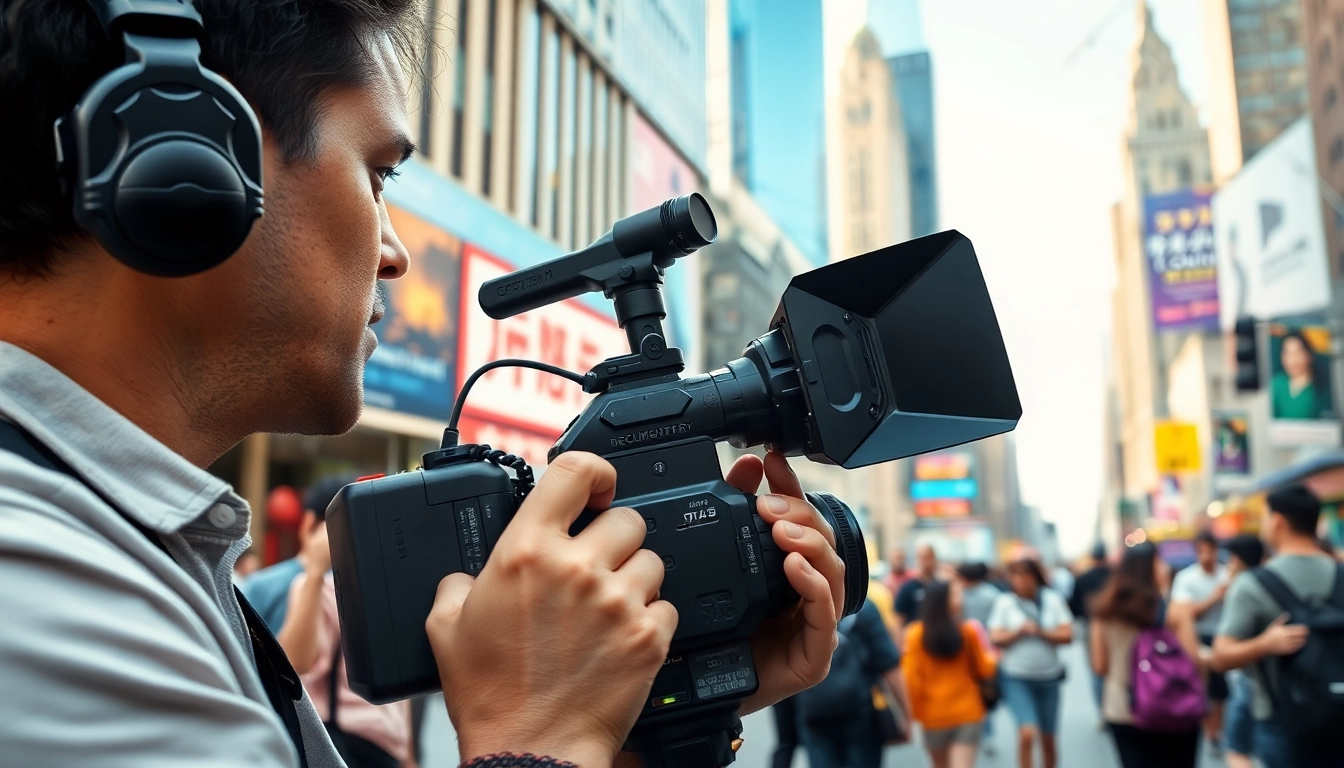Understanding the Essence of Stories & Documentaries
In an era where information is plentiful yet fleeting, stories and documentaries have navigated the landscape of narrative, offering depth and authenticity. The magic of these formats lies in their ability to convey truth through a lens of creativity. They serve as conduits for personal experiences, historical moments, and cultural reflections. By engaging with Stories & Documentaries, audiences can glean insights that are often overshadowed by surface-level narratives found in mainstream media.
What Defines a Compelling Documentary?
A compelling documentary transcends mere facts and figures; it paints a vivid picture of reality that resonates with viewers. It combines meticulous research with powerful storytelling elements, creating a tapestry where individuals can connect emotionally. A successful documentary often possesses several key attributes:
- Clear Purpose: Each documentary begins with a clear intent, be it to inform, provoke thought, or inspire change.
- Authentic Voices: Utilizing real people and their stories provides a sense of authenticity that scripted narratives often lack.
- Emotional Engagement: The ability to evoke emotions is crucial. Whether it’s humor, sorrow, or outrage, documentaries leverage these feelings to forge connections.
- Visual and Auditory Aesthetics: High-quality cinematography and sound design complement the narrative, ensuring that the viewer’s experience is immersive.
Documentaries that harness these elements tend to leave a lasting impact on the audience, enriching their understanding of complex subjects.
The Role of Storytelling in Documentaries
Storytelling is the essence of documentaries. It serves as the framework through which facts are woven into engaging narratives. Well-crafted stories allow audiences to relate personal and abstract concepts, facilitating a deeper understanding of the subject matter. The storytelling process in documentaries can be broken down into a few essential components:
- Character Development: By focusing on the experiences of individuals, documentaries create relatable characters whose journeys drive the narrative forward.
- Conflict and Resolution: Every story contains conflict, and addressing these challenges is vital for narrative progression. Documentaries often showcase the struggle and eventual resolution, highlighting resilience and hope.
- Contextualization: Setting the scene and providing background information ensures that the audience comprehends the complexities of the issues being discussed.
- Conclusions and Revelations: The ending of a documentary can be equally impactful. Whether it ends with a call to action, a reflection, or an open-ended question, it leaves viewers pondering their role in the narrative.
Effective storytelling, therefore, not only informs but also allows for a shared experience between the storyteller and the audience.
Why Stories & Documentaries Matter in Society
Stories and documentaries play a crucial role in shaping societal perceptions and igniting conversations around pressing issues. They offer a platform for marginalized voices, ensuring that diverse perspectives are represented. Additionally, the impact of documentaries can be significant in several ways:
- Awareness Raising: Documentaries often bring attention to underreported topics, such as social injustices, environmental concerns, or historical events.
- Fostering Empathy: By sharing personal stories, documentaries create a space for audiences to empathize with individuals and groups they may have never encountered.
- Education and Advocacy: Documentaries serve as educational tools that not only inform viewers but also inspire them to take action on important issues.
- Documenting History: They capture moments in time, preserving experiences and perspectives for future generations, ensuring that history is not forgotten.
In sum, stories and documentaries are vital for fostering a culture of understanding, awareness, and collaboration in society.
Key Elements of Effective Stories & Documentaries
Creating an impactful documentary is not a simple process; it requires a well-thought-out approach. Several key elements contribute to the effectiveness of such films, ensuring they resonate with the audience.
Researching and Developing Your Theme
Thorough research forms the backbone of any compelling documentary. This encompasses everything from understanding the subject matter to recognizing the broader context. Filmmakers should:
- Identify a Theme: A focused theme allows for a coherent narrative and aids in decision-making throughout production.
- Gather Information: Comprehensive research ensures that all factual elements are correct, which enhances credibility.
- Explore Various Perspectives: Engaging with multiple viewpoints enriches the narrative and gives a more nuanced depiction of the subject.
- Establish a Connection: Filmmakers should connect personally with their theme, which can lead to greater passion and authenticity in storytelling.
Developing a robust theme, backed by thorough research, sets a solid foundation for constructive storytelling.
Interview Techniques That Enhance Authenticity
Interviews are pivotal in documentary filmmaking—they are often where the narrative begins to take shape. Employing effective interview techniques can enhance the depth and authenticity of the documentary. Consider the following tips:
- Create a Comfortable Atmosphere: To elicit candid responses, it’s essential to make interviewees feel at ease. This may involve casual conversation before filming or choosing a familiar environment.
- Prepare Open-Ended Questions: Crafting questions that allow interviewees to share their stories in depth leads to more comprehensive and engaging responses.
- Practice Active Listening: Being attentive during interviews is key. It encourages interviewees to share more and fosters a genuine dialogue.
- Be Flexible: While having a structured approach is beneficial, being adaptable can lead to unexpected insights and richer narratives.
Successfully executed interviews can significantly elevate the quality and credibility of a documentary.
Visual Storytelling: Cinematography and Editing
Visual elements are crucial in documentaries, as they convey emotion and context in ways that words alone cannot. Here are components to consider in visual storytelling:
- Cinematography: Excellent cinematography involves planning shots thoughtfully, using appropriate lighting, and capturing images that reflect the emotional tone of the story.
- Editing Rhythm: The editing process shapes the pace and flow of the documentary. A skilled editor can enhance storytelling through careful cuts and transitions.
- Use of B-Roll: Supplementary footage, or B-roll, can be employed to provide context, illustrate points, and add visual interest.
- Sound Design: Sound plays a vital role in creating atmosphere. Background music, sound effects, and voiceovers should be used judiciously to enhance the emotional weight of the film.
By mastering cinematography and editing, filmmakers can craft a visually compelling narrative that captures and holds the audience’s attention.
Common Challenges in Producing Stories & Documentaries
Despite the rewarding nature of documentary filmmaking, it is not without its challenges. Awareness and preparedness can help to navigate potential obstacles effectively.
Overcoming Budget Constraints and Resources
Documentaries are often produced on limited budgets, posing challenges to filmmakers. However, innovation can create avenues for success:
- Utilize Crowdfunding: Platforms like Kickstarter or GoFundMe can be effective for raising funds while building a community around the project.
- Pursue Grants and Funding Opportunities: Various organizations offer grants specifically for filmmakers working on documentary projects.
- Leverage Technology: Advances in technology have made high-quality filming equipment more accessible. Utilizing smartphones and affordable editing software can help reduce costs.
- Work with Collaborators: Partnering with other filmmakers can lead to resource sharing and reduced individual financial burdens.
By proactively addressing budget constraints, filmmakers can successfully bring their visions to life.
Navigating Ethical Dilemmas in Filmmaking
Ethical dilemmas often arise during the filmmaking process. Documentarians have a responsibility to portray truthfully while respecting their subjects:
- Informed Consent: Obtaining explicit consent from participants is paramount, ensuring they understand how their stories will be presented.
- Avoiding Exploitation: Filmmakers should be cautious not to exploit vulnerable subjects for sensationalism, keeping integrity at the forefront of their work.
- Accuracy in Representation: Striving for accuracy while telling a story acknowledges the complexity of lived experiences.
- Transparency: Being open about potential biases in perspective and narrative can foster trust between filmmakers and audiences.
By addressing ethical concerns, filmmakers can create documentaries that honor their subjects and fulfill their storytelling potential.
Balancing Artistic Vision with Audience Expectations
Finding equilibrium between artistic vision and audience preferences can be challenging. This requires understanding the target audience while remaining true to the original vision:
- Conduct Audience Research: Understanding the audience’s interests and preferences can guide the storytelling process without compromising artistic integrity.
- Engage Feedback Loops: Incorporating feedback from test screenings can help creators gauge audience reactions and adjust accordingly.
- Iterate on Concepts: Flexibility in creative concepts allows filmmakers to evolve while maintaining their signature style.
- Build a Unique Brand: By establishing a distinctive voice, filmmakers can attract an audience that appreciates their unique perspective.
Striking the right balance between vision and expectation enables filmmakers to create art that resonates while staying true to their narrative.
Best Practices for Filmmakers and Storytellers
The documentary filmmaking process can be streamlined and strengthened through best practices. These guidelines can help ensure a successful outcome.
Building a Strong Narrative Arc
A strong narrative arc keeps viewers engaged and helps convey the intended message. This arc typically includes:
- Exposition: Introduce the key themes, characters, and context at the beginning.
- Rising Action: Present challenges or conflicts that the characters face as the story unfolds.
- Climax: Build towards the most intense point of the story, where tensions peak.
- Falling Action: Show the unfolding of events leading to the resolution.
- Resolution: Conclude the narrative with a satisfying end, whether that involves closure or open-ended questions.
A well-structured narrative arc ensures that audiences remain captivated from start to finish.
Engaging Your Audience Through Distribution
Distribution strategies are vital in ensuring that documentaries reach their intended audiences. Effective distribution involves:
- Identifying Target Audiences: Understanding who will be most beneficial from the documentary guides distribution decisions.
- Leveraging Film Festivals: Participating in film festivals can optimize exposure and attract distributors.
- Utilizing Online Platforms: Streaming services and social media offer accessible avenues for audiences to discover and engage with documentaries.
- Creating Community Screenings: Holding local screenings encourages engagement and discussion among viewers.
Implementing a targeted distribution plan can amplify the documentary’s reach and impact.
Utilizing Social Media to Amplify Your Voice
Social media platforms serve as vital tools for promoting documentaries and engaging with audiences:
- Develop the Documentary’s Brand: Establishing a recognizable and relatable brand enhances visibility.
- Create Compelling Content: Sharing behind-the-scenes footage, interviews, and imagery can intrigue potential viewers.
- Engage with Followers: Building a community around the documentary fosters loyal viewership and ongoing discussions.
- Utilize Hashtags and Trends: Effectively utilizing hashtags raises awareness and broadens the reach of the content.
Utilizing social media proactively can significantly boost a documentary’s visibility and viewer interaction.
Measuring Success: Analyzing Impact and Reach
Documentary filmmakers should measure the impact of their work through various analytical methods. Understanding how the documentary resonates with audiences informs both future projects and ongoing discussions.
Key Performance Metrics for Documentaries
Filmmakers can assess documentary success using various key performance indicators (KPIs):
- Viewership Numbers: Monitoring how many people view the documentary across different platforms provides insights into reach.
- Engagement Analytics: Assessing likes, shares, and comments can help gauge audience reactions and overall appreciation.
- Critical Reception: Analyzing reviews and ratings from critics can add depth to understanding audience impact.
- Social Media Growth: Tracking follower counts and engagement on social media platforms can reflect the documentary’s viral potential.
Utilizing these metrics aids in understanding the documentary’s trajectory and future engagement opportunities.
Gathering Audience Feedback and Reactions
Audience feedback is invaluable for gauging the resonance of a documentary:
- Surveys and Questionnaires: Distributing surveys can provide quantitative feedback regarding viewer satisfaction and takeaways.
- Focus Groups: Engaging with small groups to discuss the documentary can provide qualitative insights and deeper understanding.
- Public Forums: Hosting discussions or panels can foster community dialogue and provide feedback directly from viewers.
- Online Reviews: Monitoring discussions on platforms where the documentary is available can offer critical viewer perspectives.
Actively seeking out feedback allows filmmakers to evolve and respond to their audience’s desires and expectations.
Adapting Strategies Based on Performance Data
Ultimately, recognizing trends and adapting strategies is crucial:
- Data Analysis: Reviewing data can reveal viewer demographics, engagement patterns, and preferences, guiding future projects.
- Refinement of Messaging: Insights from feedback can help refine messaging, ensuring it resonates more effectively moving forward.
- Iterative Improvements: The ability to apply lessons learned to new projects can bolster the quality and effectiveness of future documentaries.
- Building Long-Term Relationships: Engaging with the community and maintaining an ongoing dialogue with audiences fosters loyalty.
Adaptive strategies based on performance data help filmmakers remain relevant and continually improve their storytelling.



